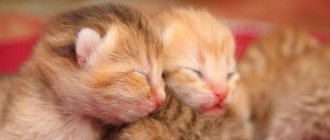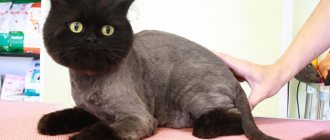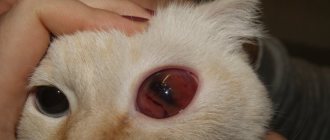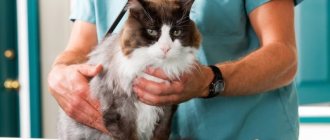7014Pavel
1
Cats, for the most part and regardless of age, are very playful and active animals. That is why many owners are perplexed and often ask the question: “until what age is a kitten considered a kitten?” It is difficult to give a definite answer to this question. Largely because this issue is individual for each cat.
In this article we will talk about the main stages of a kitten’s development, and we will also try to come to a conclusion when a kitten finally becomes an adult cat.
© instagram.com/juliaolimpian
Growth and development
Kittens experience a big growth spurt between 2 and 6 months of age. Around six months of age, most kittens begin to look virtually like adult cats, although this always depends on the individual animal. During this period of time, it is especially important to feed your pet enough protein, ideally 4 times a day.
Foods developed specifically for growing kittens optimally meet the needs of their growing bodies, as they contain all the necessary components. After 6 months, grown kittens are already fine eating regular food for adult cats. To be completely sure about the correct transition to a new diet, you can consult your veterinarian about this.
Determining the age of a cat by behavior
Each cat has a unique character, which largely determines its behavior. Persians, for example, are very calm and unhurried, Abyssinians are restless and sociable, Canadian Sphynxes are unusually intelligent and flexible, and Maine Coons are good-natured but freedom-loving. However, we can identify several common behavioral characteristics that are characteristic of pets at different stages of their life:
- During the first fourteen days of life, babies move by crawling;
- three-week-old kittens try to walk, but they do it clumsily - the babies tremble and fall every now and then;
- by the month of life they are already confidently standing on their paws, learning to run, jump, land, use their claws and actively explore the surrounding space;
- two-month-old naughty dogs are playful, sociable, curious, active, they can surprise their owner with unexpected pirouettes and demonstrate miracles of tightrope walking;
At two months, kittens become very playful and curious. - adult cats show moderate interest in new objects, but are more reasonable and careful, follow established habits, they still love to play and hunt, but often prefer to just take a nap;
- With age, this desire only increases, and the animal sleeps during the day and becomes more active at night.
If little ones are able to turn everything they see into a toy, then adults show special creativity when choosing a sleeping place.
Video: kittens from birth to one month
To prevent an adult sloth from becoming fat, the owner will have to take the initiative into his own hands and, calling on all his ingenuity to help, come up with new and original entertainment for him to replace the boring ones. Physical activity will allow your pet to stay healthy for a long time.
The character of older cats begins to deteriorate. The animal can be capricious, demand attention, treats, and become touchy and jealous. The appearance of a new pet in the family, the intrusion of an uninvited guest, the annoying attention of small children, changing the tray or filler, moving can disrupt his peace of mind for a long time.
Often, a pet’s mood worsens due to health problems. Decreased hearing and vision provoke fearfulness and nervousness, and chronic diseases of internal organs cause discomfort and irritation. In this case, you need to provide the animal with a comfortable and warm sleeping place away from prying eyes, noise and fuss, allowing it to calmly recuperate. It would also be useful to consult a veterinarian to treat concomitant diseases and alleviate the condition of an elderly pet.
My Manka is nocturnal, and during the day prefers to doze peacefully. As dusk sets in, she goes for a run from one end of the apartment to the other, knocking down all the corners along the way. The tramp of her paws rattles the dishes in the cabinets. But it doesn’t last long, so after making three passes, she falls heavily to the side and takes a long time to recover her breathing. Manya was always timid, looked at strangers unfriendly and recognized only family members. With age, our favorite has completely stopped giving in to hands and only occasionally allows itself to be stroked and stretched withers. Her trust in us was irretrievably lost after treatment with injections and pills. Four years have passed since then, but Manya has never forgiven us.
Adolescence
When your kittens are around 5 or 6 months old, they can be considered teenagers. So maybe you should start looking out for them! Most kittens reach sexual maturity around this time. During this period, cats begin their heat cycle and male cats begin to exhibit their behavioral patterns and play “love games.” They begin to mark territory, walk around the area and fight. However, although all cats reach sexual maturity at 5-6 months, some reach it much earlier, and some much later.
What influences growth rates
The rate of growth and development directly depends on several factors:
- Breed. The main factor influencing the size of an adult cat is its breed. Thus, Maine Coons grow up to 2 years of age, but individuals are recognized as truly adults only by 3 years of age. Representatives of the female half of the Bengal breed reach their maximum size at 9 months, and the male half at 2 years. The physical development of the British, as well as the Scots, continues until 2.5-3 years. Siberian cats grow up to 1.5 years, sphinxes - up to 2 years. Non-pedigreed or, as they are more often called, domestic cats, due to their mixed genotype, do not have developmental norms, therefore some of them stop growing as early as one year, others increase in size up to 3 years.
- Heredity. It is very rare for kittens to grow larger than their parents. Only in rare cases does a small cat grow into a large kitten.
- Gender. Cats are always smaller than cats.
- Food quality. A deficiency of vitamins and important macro- and microelements leads to a slowdown or complete cessation of growth, disproportionate to the development of the body.
- Living conditions. Comfortable room temperature, proper lighting, hygiene, high quality sleep stimulate the proper development of the kitten.
- Diseases and parasites. Diseases of any type (hereditary, infectious, somatic) impair growth. Intestinal parasites, which suck out the vitamins and nutrients required by the pet, also have an adverse effect on the development of the body.
- Lifestyle. Physically active kittens develop faster, their body is proportional in size, and their weight is normal.
- Work of the endocrine system. Hormonal imbalances negatively affect a pet's growth. By the way, stress can also provoke endocrine imbalance, during which certain hormones are produced.
- Sterilization. Cats that are neutered at a later age tend to be larger in size than cats that are not spayed and those that were spayed before the age of one year.
- Mating age. Despite the fact that male cats are considered sexually mature by 8 months, mating at such an early period leads to a slowdown in growth, and sometimes even to its cessation.
Kitten development by week
| Age (weeks) | External manifestations |
| There is an umbilical cord, eyes and ears are closed tightly. | |
| The eyes open. | |
| Ears rise, eyes are completely open. | Small but sharp anterior ones emerge. |
| The baby becomes playful and explores the environment | Long fangs appear next to the front ones. |
| Stands steady on his feet | Milk teeth appear behind the fangs and on the sides of the jaw. |
| High traffic activity. | |
| The cat eats and washes itself. | All baby teeth have appeared. |
| Normal weight for an adult of the breed. | Molar incisors appear. |
| 4-6 months | The distant molars and canines are erupting. |
| 7 months | The indigenous ones have completely cut through everything. |
We suggest you read: False pregnancy in a cat, how to avoid complications
So when is the best time to adopt a kitten?
You can bring a cat child into a new home when he is ready to live without his mother. Here are the signs of his independence:
- He was at least 3 months old.
- He no longer suckles the cat's milk.
- Knows the litter tray and scratching post.
- Licks and washes itself.
- He eats well, is well-fed, and his weight is within normal limits.
- He is not afraid of a person, shows curiosity and interest in him.
- He received his first vaccinations and developed immunity under familiar conditions.
How kittens grow
The surest way to determine the age of a kitten is by observing it. There are certain periods of development of an organism that indicate the date of its birth. The older the pet, the more difficult it is to know exactly how old he is. The easiest way to do this is before 1 month, when the main stages of the formation of all animal body systems occur:
- the umbilical cord disappears;
- the baby begins to stand on his feet;
- body weight increases;
- eyes open, their color changes;
- teeth appear and grow.
What determines the speed of puberty in cats and cats?
The beginning of puberty in cats depends on the breed: representatives of sphinxes, Thais, Siamese, orientals, and other species belonging to the oriental type enter adulthood earlier than their counterparts. Animals of “graceful” build are also prone to early awakening of libido, even if they belong to a mongrel breed.
Kittens born in winter may already feel the call of nature in summer or late spring. Early puberty is observed in nurseries or when owners keep several individuals, especially if some of them are already adults. Pheromones of sexually mature relatives contribute to the rapid maturation of young animals.
Pets that receive a sufficient amount of high-quality nutrition develop faster than their street peers living from hand to mouth. Don't write off genetic predisposition.
Adaptation of a cat to the house
So, you took an adult cat into your home. What problems might there be? First of all, this is toilet training. In the first days, limit your pet's movements around the house to one room or area - this will make it easier for her to understand where the tray is, and it will be easier for you to make sure that the cat has not organized a secret toilet under your bed.
It is advisable that in the room allocated for the cat there are no too secluded places, otherwise the frightened animal may hide under the sofa and spend several days there. At the same time, the process of pulling him out from under the sofa clearly will not lay a good foundation for a trusting relationship. Don’t rush with bathing, let the new tenant get used to you.
Try not to have noisy parties or general cleaning. You should also not go on vacation during this period and leave your new cat in the care of your neighbors. If your pet is afraid of someone and spends all its time in hiding, try to stay more in its field of vision while doing your usual things, but do not insist on contact (do not pick up the cat or forcefully stroke it).
Why do kittens have big paws?
Just like our human babies, especially white-skinned ones, newly born kittens have a low level of pigment in their eyes, which is responsible for color.
A thin film remains on the eyes of kittens as a protective mechanism against bright light, which, passing through the lens, can burn the retina. And a cloudy film appears in the womb, during the formation of the fetus. Kittens make sounds that are inaudible to the human ear. The mother cat hears them, but people do not. Most likely, nature created it this way so that in the wild, as few predators and people as possible could find cat offspring by sound. But over time, “speech” should appear.
Don't worry about the "sailor's gait" in kittens. This is just temporary muscle weakness, characteristic of them at a young age. Diseases such as dysplasia and myopathy are diagnosed only at six months of age and older, so just admire your pet and often take videos of his short trips around the apartment.
Large paws in relation to other parts of the body are a sign of the breed. The larger the cat grows, the greater the discrepancy.
If the kitten has just begun to get accustomed to cleanliness and has not yet fully figured out what exactly the tray is intended for, he may sometimes take a nap there.
This happens because the kitten feels safe in the tray, and therefore can simply lie down to rest in its own “potty” and sleep.
Choosing a cat
In addition to personality traits, it is important that the cat is clinically healthy, vaccinated and sterilized. In some cases, people take home quite elderly pets or even those with chronic illnesses from the shelter. In such situations, it is important to clearly understand what kind of disease we are talking about and what consequences and expenses this may lead to.
In a shelter environment, it is difficult to understand the character of a cat. If she comes up to people and allows herself to be petted, most likely she is quite socially adjusted. On the other hand, a cat may be very frightened and even aggressive at the first meeting, but this does not mean that it will remain so in the future.
It is important to talk with the service staff about the habits and characteristics of the chosen animal, and also describe your conditions (other animals, children, small apartment). Some cats, for example, will do well with a dog, but will not get along well with children, which can lead to behavior or cleanliness problems.
Choosing the right pet, taking into account all the features of the new family, is the best prevention of animals returning to the shelter. If you want to get advice from those who have already adopted an adult cat at home, go to the relevant forum. “I wanted to adopt an adult cat, I need advice,” this is how your message may begin.
You can also ask who to take, and where is the best place to take a cat, they will definitely tell you what to do and give you a lot of advice. If you are not ready to go to a shelter for a cat, try advertising on specialized websites on the Internet or on your page in social networks. You can write, for example, “I’m taking an adult cat into the house, is someone giving the cat into good hands?” As a rule, it is difficult to adopt such cats, so people will probably respond willingly.











